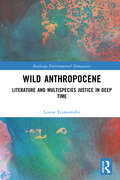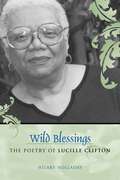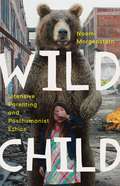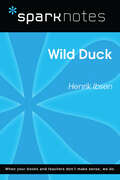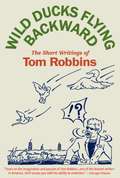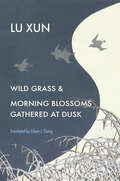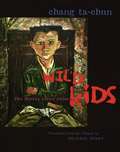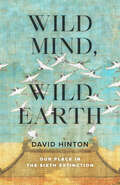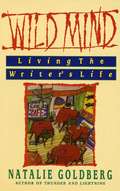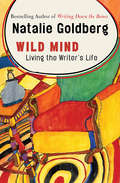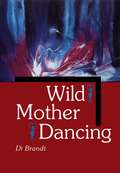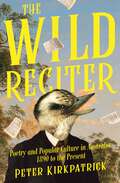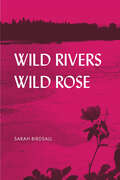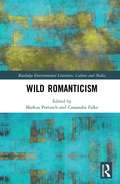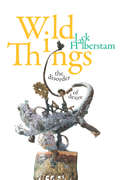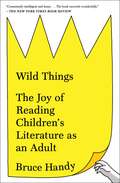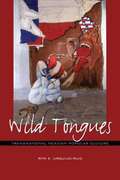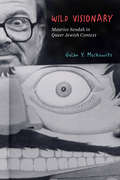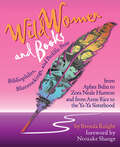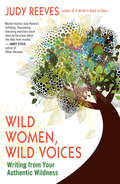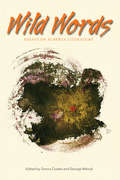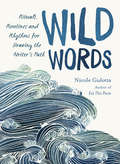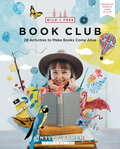- Table View
- List View
Wild Anthropocene: Literature and Multispecies Justice in Deep Time (Routledge Environmental Humanities)
by Louise EconomidesWild Anthropocene examines four key areas—the politics of deep time, neoliberalism's socio-ecological impacts, global population growth and inter-species entanglement—to demonstrate how literature illuminates progressive solutions to Anthropocene challenges. The book argues that technological mitigation of contemporary environmental crises must be complimented by a politics committed to multispecies justice. Central to this new politics is the project of reimagining our relationship with time as something other than its status within capitalist praxis.The book brings together poetry and fiction written by a diverse range of writers to demonstrate how contemporary literature addresses important connections between social oppression and environmental issues. It also critiques techno-managerial visions of the future that celebrate humanity's ever-growing "control" over ecosystems by examining multiple sources of wildness (temporal, environmental and technological) that expose the problematic ideology underwriting such aspirations. Readers will be introduced to a way of understanding the Anthropocene that, while being informed by recent discoveries in earth science and evolutionary biology, also makes a strong case for humanities-based understanding of environmental politics.This interdisciplinary text will be a useful addition to theoretical discussions on the Anthropocene for scholars, researchers and students in the environmental humanities, literary studies, ecocriticism and environmental philosophy.
Wild Blessings: The Poetry of Lucille Clifton (Southern Literary Studies)
by Hilary HolladayWidely acclaimed for her powerful explorations of race, womanhood, spirituality, and mortality, poet Lucille Clifton has published thirteen volumes of poems since 1969 and has received numerous accolades for her work, including the 2000 National Book Award for Blessing the Boats. Her verse is featured in almost every anthology of contemporary poetry, and her readings draw large and enthusiastic audiences. Although Clifton's poetry is a pleasure to read, it is neither as simple nor as blithely celebratory as readers sometimes assume. The bursts of joy found in her polished, elegant lines are frequently set against a backdrop of regret and sorrow. Alternately consoling, stimulating, and emotionally devastating, Clifton's poems are unforgettable. In Wild Blessings, Hilary Holladay offers the first full-length study of Clifton's poetry, drawing on a broad knowledge of the American poetic tradition and African American poetry in particular. Holladay places Clifton's poems in multiple contexts -- personal, political, and literary -- as she explicates major themes and analyzes specific works: Clifton's poems about womanhood, a central concern throughout her career; her fertility poems, which are provocatively compared with Sylvia Plath's poems on the same subject; her relation to the Black Arts Movement and to other black female poets, such as Gwendolyn Brooks and Sonia Sanchez; her biblical poems; her elegies; and her poignant family history, Generations, an extended prose poem. In addition to a new preface written after Clifton's death in 2010, this updated edition includes an epilogue that discusses the poetry collections she published after 2004.Readers encountering Lucille Clifton's poems for the first time and those long familiar with her distinctive voice will benefit from Hilary Holladay's striking insights and her illuminating interview with the influential American poet.
Wild Cat Falling
by MudroorooThis was the first novel by a writer of Aboriginal blood to be published in Australia and in 1965 marked a unique literary event. Wild Cat Falling is the story of an Australian Aboriginal youth who grows up on the ragged outskirts of a country town. He falls into petty crime, goes to gaol and comes out to do battle once more with the society that put him there. Mudrooroo is active in Aboriginal cultural affairs and is a prolific writer.
Wild Child: Intensive Parenting and Posthumanist Ethics
by Naomi MorgensternExploring how the figure of the &“wild child&” in contemporary fiction grapples with contemporary cultural anxieties about reproductive ethics and the future of humanity In the eighteenth century, Western philosophy positioned the figure of &“the child&” at the border between untamed nature and rational adulthood. Contemporary cultural anxieties about the ethics and politics of reproductive choice and the crisis of parental responsibility have freighted this liminal figure with new meaning in twenty-first-century narratives.In Wild Child, Naomi Morgenstern explores depictions of children and their adult caregivers in extreme situations—ranging from the violence of slavery and sexual captivity to accidental death, mass murder, torture, and global apocalypse—in such works as Toni Morrison&’s A Mercy, Cormac McCarthy&’s The Road, Lionel Shriver&’s We Need to Talk about Kevin, Emma Donoghue&’s Room, and Denis Villeneuve&’s film Prisoners. Morgenstern shows how, in such narratives, &“wild&” children function as symptoms of new ethical crises and existential fears raised by transformations in the technology and politics of reproduction and by increased ethical questions about the very decision to reproduce. In the face of an uncertain future that no longer confirms the confidence of patriarchal humanism, such narratives displace or project present-day apprehensions about maternal sacrifice and paternal protection onto the wildness of children in a series of hyperbolically violent scenes.Urgent and engaging, Wild Child offers the only extended consideration of how twenty-first-century fiction has begun to imagine the decision to reproduce and the ethical challenges of posthumanist parenting.
Wild Duck (SparkNotes Literature Guide Series)
by SparkNotesWild Duck (SparkNotes Literature Guide) by Henrik Ibsen Making the reading experience fun! Created by Harvard students for students everywhere, SparkNotes is a new breed of study guide: smarter, better, faster. Geared to what today's students need to know, SparkNotes provides: *Chapter-by-chapter analysis *Explanations of key themes, motifs, and symbols *A review quiz and essay topicsLively and accessible, these guides are perfect for late-night studying and writing papers
Wild Ducks Flying Backward
by Tom RobbinsKnown for his meaty seriocomic novels, Tom Robbins's shorter work has appeared in publications ranging from Esquire to Harper's, from Playboy to the New York Times. Collected here for the first time in paperback, the essays, articles, observations--and even some untypical country-music lyrics--offer a rare overview of the eclectic sensibility of an American original. Whether rocking with the Doors, depoliticizing Picasso's Guernica, lamenting the angst-ridden state of contemporary literature, or drooling over tomato sandwiches and a species of womanhood he calls "the genius waitress," Tom Robbins's briefer writings exhibit the five traits that perhaps best characterize his novels: an imaginative wit, a cheerfully brash disregard for convention, a sweetly nasty eroticism, a mystical but keenly observant eye, and an irrepressible love of language. Embedded in this primarily journalistic compilation are brand-new short stories, a sheaf of largely unpublished poems, and an offbeat assessment of our divided nation. herever you open Wild Ducks Flying Backward, you'll encounter the serious playfulness that percolates from the mind of a self-described "romantic Zen hedonist" and "stray dog in the banquet halls of culture. "
Wild Grass and Morning Blossoms Gathered at Dusk
by Xun LuA brilliant new translation of the short improvisational fiction and memoirs of Lu Xun, the father of modern Chinese literature.This captivating translation assembles two volumes by Lu Xun, the founder of modern Chinese literature and one of East Asia’s most important thinkers at the turn of the twentieth century. Wild Grass and Morning Blossoms Gathered at Dusk represent a pinnacle of achievement alongside Lu Xun’s famed short stories.In Wild Grass, a collection of twenty-three experimental pieces, surreal scenes come alive through haunting language and vivid imagery. These are landscapes populated by ghosts, talking animals, and sentient plants, where a protagonist might come face-to-face with their own corpse. By depicting the common struggle of real and imagined creatures to survive in an inhospitable world, Lu Xun asks the deceptively simple question, “What does it mean to be human?”Alongside Wild Grass is Morning Blossoms Gathered at Dusk, a memoir in eight essays capturing the literary master’s formative years and featuring a motley cast of dislocated characters—children, servants, outcasts, the dead and the dying. Giving voice to vulnerable subjects and depicting their hopes and despair as they negotiate an unforgiving existence, Morning Blossoms affirms the value of all beings and elucidates a central predicament of the human condition: feeling without a home in the world.Beautifully translated and introduced by Eileen J. Cheng, these lyrical texts blur the line between autobiography and literary fiction. Together the two collections provide a new window into Lu Xun’s mind and his quest to find beauty and meaning in a cruel and unjust world.
Wild Kids: Two Novels About Growing Up (Modern Chinese Literature from Taiwan)
by Ta-Chun ChangThese two searingly funny and unsettling portraits of teenagers beyond the control and largely beneath the notice of adults in 1980s Taiwan are the first English translations of works by Taiwan's most famous and best-selling literary cult figure. Chang Ta-chun's intricate narrative and keen, ironic sense of humor poignantly and piercingly convey the disillusionment and cynicism of modern Taiwanese youth.Interweaving the events between the birth of the narrator's younger sister and her abortion at the age of nineteen, the first novel, My Kid Sister, evokes the complex emotional impressions of youth and the often bizarre social dilemmas of adolescence. Combining discussions of fate, existentialism, sexual awakening, and everyday "absurdities" in a typically dysfunctional household, it documents the loss of innocence and the deconstruction of a family.In Wild Child, fourteen-year-old Hou Shichun drops out of school, runs away from home, and descends into the Taiwanese underworld, where he encounters an oddball assortment of similarly lost adolescents in desperate circumstances. This novel will inevitably invite comparisons with the classic The Catcher in the Rye, but unlike Holden Caulfield, Hou isn't given any second chances. With characteristic frankness and irony, Chang's teenagers bear witness to a new form of cultural and spiritual bankruptcy.
Wild Mind, Wild Earth: Our Place in the Sixth Extinction
by David HintonExploring the confluence of ancient Chinese spirituality and modern Western environmental thought, Wild Mind, Wild Earth reveals the unrecognized kinship of mind and nature that must be reanimated if we are to end our destruction of the planet.Earth is embroiled in its sixth major extinction event—this time caused not by asteroids or volcanos, but by us. At bottom, preventing this sixth extinction is a spiritual/philosophical problem, for it is the assumptions defining us and our relation to earth that are driving the devastation. Those assumptions insist on a fundamental separation of human and earth that devalues earth and enables our exploitative relation to it.In Wild Mind, Wild Earth, David Hinton explores modes of seeing and being that could save the planet by reestablishing a deep kinship between human and earth: the insights of primal cultures and the Ch&’an (Zen) Buddhism of ancient China. He also shows how these insights have become well-established in the West over the last two hundred years, through the work of poets and philosophers and scientists. This offers marvelous hope and beauty—but like so many of us, Hinton recognizes the sixth extinction is now an inexorable and perhaps unstoppable tragedy. And he reveals how those primal/Zen insights enable us to inhabit even the unfurling catastrophe as a profound kind of liberation. Wild Mind, Wild Earth is a remarkable and revitalizing journey.
Wild Mind: Living the Writer's Life
by Natalie GoldbergNatalie Goldberg, who has published a novel, a book of poetry and books on how to be a writer, has written 62 3 to four page chapters, each focuses on elements of writing or the experiences shared by many writers in this book which is part memoir and part instruction manual. She is a practitioner of Zen Buddhism which influences her manner of appreciating everything in her life from her friends, family and acquaintances, to the taste of hot chocolate, the vastness of the sky and the energy you gain as you keep your pencil moving and write with truth and details. She provides many gentle suggestions for exercises meant to expand a writer's understanding of the vast possibilities writing can elucidate. Her tone is generous, humorous, nonthreatening, nonjudgmental, encouraging and down to earth. She shares a writer's moments of exquisite pleasure as new heights of self expression are reached and as the moments of self doubt, fear and frustration are borne. Most of all she welcomes anyone with the will to take time, on a regular basis, to write to proudly call themselves writers believing that as each person adopts the title of writer and writes with persistence and concentration through the rapture and pain of truth as they perceive it, they become practicing writers of worth.
Wild Mind: Living the Writer's Life
by Natalie GoldbergSet your creativity free with a writing guide that &“wakes you up like a cross between morning coffee and a friendly Zen master&” (Jack Kornfield). Natalie Goldberg, author of the bestselling Writing Down the Bones, shares her invaluable insight into writing as a source of creative power, and the daily ins and outs of the writer&’s task. Topics include balancing mundane responsibilities with a commitment to writing; knowing when to take risks as a writer and a human being; coming to terms with success, failure, and loss; and learning self-acceptance—both in life and art. Thought-provoking and practical, Wild Mind provides an abundance of suggestions for keeping the writing life vital and active, and includes more than thirty provocative &“try this&” exercises as jump-starters to get your pen moving. This ebook features an illustrated biography of Natalie Goldberg, including rare photos and never-before-seen documents from the author&’s personal collection.
Wild Mother Dancing: Maternal Narrative in Canadian Literature
by Di BrandtWild Mother Dancing challenges the historical absence of the mother, who, as subject and character, has been repeatedly suppressed and edited out of the literary canon. In her search for sources for telling the new (or old, forbidden story) against a tradition of narrative absence, Brandt turns to Canadian fiction representing a varety of cultural traditions - Margaret Laurence, Daphne Marlatt, Jovette Marchessault, Joy Kogawa, Sky Lee - and a collection of oral interviews about childbirth told by Mennonite women. The results broaden, enrich, and finally recover the motherstory in ways that have revolutionary implications for our institutions and imaginations.
Wild Reciter: Poetry and Popular Culture in Australia 1890-2020
by Peter KirkpatrickJust over a century ago poetry was all the rage in Australia. Newspapers and magazines published it, entertainers and elocutionists performed it on stages across the country, and ordinary Australians recited it in schools, local halls and suburban parlours. Yet this communal experience of poetry has now largely disappeared. In The Wild Reciter Peter Kirkpatrick examines how this change occurred by exploring the shifting relationships between poetry and popular culture, and in particular the arrival of new media, taking the reader from 'penny readings' and vaudeville to slam and Instapoetry. Many extraordinary yet wholly forgotten works are brought to light, while some well-known poems and their authors receive a critical makeover. 'The Man from Snowy River' encounters the Wild West; Lesbia Harford turns singer-songwriter; Kenneth Slessor finds his groove; Yevgeny Yevtushenko blows up the Adelaide Festival; rock music inspires both John Laws and the Generation of '68; Dorothy Porter resorts to crime fiction; and Clive James abandons media fame for poetic glory. This pioneering study reimagines the history of Australian verse to arrive at a more expansive notion of poetry.
Wild Rivers, Wild Rose (The Alaska Literary Series)
by Sarah BirdsallIn 1941, Anna Harker is attacked by an ax-wielding assailant in the gold-bearing ridges bordering the Alaska Range. It is this moment of savagery that propels the people of Wild Rivers, Wild Rose. Anna’s lover, Wade Daniels, learns of the deaths of Anna’s husband and their worker, and he rushes to the hills to look for Anna and hunt the murderer. As she lies dying on the tundra, Anna relives the major events of her Alaska life while searching her memories for what could have led to the violence. And, decades later, an outsider named Billie Sutherland steps into a community still haunted by the murders. Plagued by her own ghosts, Billie delves into the past, opening old wounds. In this gripping novel by Sarah Birdsall, lives are laid bare and secrets ring out in the resonant Alaska Range foothills.
Wild Romanticism (Routledge Environmental Literature, Culture and Media)
by Cassandra Falke Markus PoetzschWild Romanticism consolidates contemporary thinking about conceptions of the wild in British and European Romanticism, clarifying the emergence of wilderness as a cultural, symbolic, and ecological idea. This volume brings together the work of twelve scholars, who examine representations of wildness in canonical texts such as Frankenstein, Northanger Abbey, "Kubla Khan," "Expostulation and Reply," and Childe Harold´s Pilgrimage, as well as lesser-known works by Radcliffe, Clare, Hölderlin, P.B. Shelley, and Hogg. Celebrating the wild provided Romantic-period authors with a way of thinking about nature that resists instrumentalization and anthropocentricism, but writing about wilderness also engaged them in debates about the sublime and picturesque as aesthetic categories, about gender and the cultivation of independence as natural, and about the ability of natural forces to resist categorical or literal enclosure. This book will be of great interest to students and scholars of Romanticism, environmental literature, environmental history, and the environmental humanities more broadly.
Wild Things: The Disorder of Desire (Perverse Modernities: A Series Edited by Jack Halberstam and Lisa Lowe)
by Jack HalberstamIn Wild Things Jack Halberstam offers an alternative history of sexuality by tracing the ways in which wildness has been associated with queerness and queer bodies throughout the twentieth century. Halberstam theorizes the wild as an unbounded and unpredictable space that offers sources of opposition to modernity's orderly impulses. Wildness illuminates the normative taxonomies of sexuality against which radical queer practice and politics operate. Throughout, Halberstam engages with a wide variety of texts, practices, and cultural imaginaries—from zombies, falconry, and M. NourbeSe Philip's Zong! to Maurice Sendak's Where the Wild Things Are and the career of Irish anticolonial revolutionary Roger Casement—to demonstrate how wildness provides the means to know and to be in ways that transgress Euro-American notions of the modern liberal subject. With Wild Things, Halberstam opens new possibilities for queer theory and for wild thinking more broadly.
Wild Things: The Joy of Reading Children's Literature as an Adult
by Bruce HandyAn irresistible, nostalgic, insightful—and &“consistently intelligent and funny&” (The New York Times Book Review)—ramble through classic children&’s literature from Vanity Fair contributing editor (and father of two) Bruce Handy.The dour New England Primer, thought to be the first American children&’s book, was first published in Boston in 1690. Offering children gems of advice such as &“Strive to learn&” and &“Be not a dunce,&” it was no fun at all. So how did we get from there to &“Let the wild rumpus start&”? And now that we&’re living in a golden age of children&’s literature, what can adults get out of reading Where the Wild Things Are and Goodnight Moon, or Charlotte&’s Web and Little House on the Prairie? A &“delightful excursion&” (The Wall Street Journal), Wild Things revisits the classics of every American childhood, from fairy tales to The Very Hungry Caterpillar, and explores the back stories of their creators, using context and biography to understand how some of the most insightful, creative, and witty authors and illustrators of their times created their often deeply personal masterpieces. Along the way, Handy learns what The Cat in the Hat says about anarchy and absentee parenting, which themes are shared by The Runaway Bunny and Portnoy&’s Complaint, and why Ramona Quimby is as true an American icon as Tom Sawyer or Jay Gatsby. It&’s a profound, eye-opening experience to re-encounter books that you once treasured decades ago. A clear-eyed love letter to the greatest children&’s books and authors from Louisa May Alcott and L. Frank Baum to Eric Carle, Dr. Seuss, Mildred D. Taylor, and E.B. White, Wild Things is &“a spirited, perceptive, and just outright funny account that will surely leave its readers with a new appreciation for childhood favorites&” (Publishers Weekly).
Wild Tongues: Transnational Mexican Popular Culture
by Rita E. Urquijo-RuizTracing the configuration of the slapstick, destitute Peladita/Peladito and the Pachuca/Pachuco (depicted in flashy zoot suits) from 1928 to 2004, Wild Tongues is an ambitious, extensive examination of social order in Mexican and Chicana/o cultural productions in literature, theatre, film, music, and performance art. From the use of the Peladita and the Peladito as stock characters who criticized various aspects of the Mexican government in the 1920s and 1930s to contemporary performance art by María Elena Gaitán and Dan Guerrero, which yields a feminist and queer-studies interpretation, Rita Urquijo-Ruiz emphasizes the transnational capitalism at play in these comic voices. Her study encompasses both sides of the border, including the use of the Pachuca and the Pachuco as anti-establishment, marginal figures in the United States. The result is a historically grounded, interdisciplinary approach that re-imagines the limitations of nation-centred thinking and reading. Beginning with Daniel Venegas's 1928 novel, Las aventuras de don Chipote o Cuando los pericos mamen, Rita Urquijo-Ruiz's Wild Tongues demonstrates early uses of the Peladito to call attention to the brutal physical demands placed on the undocumented Mexican labourer. It explores Teatro de Carpa (tent theater) in-depth as well, bringing to light the experience of Mexican Peladita Amelia Wilhelmy, whose "La Willy" was famous for portraying a cross-dressing male soldier who criticizes the failed Revolution. In numerous other explorations such as these, the political, economic, and social power of creativity continually takes centre stage.
Wild Visionary: Maurice Sendak in Queer Jewish Context (Stanford Studies in Jewish History and Culture)
by Golan Y. MoskowitzWild Visionary reconsiders Maurice Sendak's life and work in the context of his experience as a Jewish gay man. Maurice (Moishe) Bernard Sendak (1928–2012) was a fierce, romantic, and shockingly funny truth seeker who intervened in modern literature and culture. Raising the stakes of children's books, Sendak painted childhood with the dark realism and wild imagination of his own sensitive "inner child," drawing on the queer and Yiddish sensibilities that shaped his singular voice. Interweaving literary biography and cultural history, Golan Y. Moskowitz follows Sendak from his parents' Brooklyn home to spaces of creative growth and artistic vision—from neighborhood movie palaces to Hell's Kitchen, Greenwich Village, Fire Island, and the Connecticut country home he shared with Eugene Glynn, his partner of more than fifty years. Further, he analyzes Sendak's investment in the figure of the endangered child in symbolic relation to collective touchstones that impacted the artist's perspective—the Great Depression, the Holocaust, and the AIDS crisis. Through a deep exploration of Sendak's picture books, interviews, and previously unstudied personal correspondence, Wild Visionary offers a sensitive portrait of the most beloved and enchanting picture-book artist of our time.
Wild Women and Books: Bibliophiles, Bluestockings, and Prolific Pens
by Brenda KnightA provocative and inspiring exploration of women writers from the first writers in history to today’s greats—with a new introduction by Ntozake Shange.Wild Women and Books celebrates some of the most revered and radical women writers of history. Beginning with the first recorded writer of either gender, Enheduanna of Sumeria, and ending with acclaimed contemporary writers like Toni Morrison and J.K. Rowling, this is a must-read for those who must read.Brenda Knight brings more than a hundred female authors to life for today's readers—from Aphra Ben to Zora Neal Hurston and from Ann Rice to the Ya-Ya Sisterhood. Knight recounts their tumultuous paths to literary acclaim in chapters such as Literary First Ladies; Ink in Their Veins; Banned, Blacklisted, and Arrested; and Women Whose Books Are Loved Too Much.From religious transcribers and political dissidents to erotic playwrights and romantic poets, no subject or literary form is left untouched. In honor of those women whose pens pioneered, persevered, and proved that the female voice is brilliant, Knight invites you to explore the literary legacy of women.
Wild Women, Wild Voices
by Judy ReevesWrite to Celebrate, Heal, and Free the Wild Woman Within In her years as a writing coach, Judy Reeves has found twin urges in women: they yearn to reclaim a true nature that resides below the surface of daily life and to give it voice. The longing to express this wild, authentic nature is what informs Reeves’s most popular workshop and now this workshop in a book. Here, you will explore the stages that make up your life, from wild child, daughter/sister/mother, and loves and lovers, to creative work, friendships, and how the wise woman encounters death. Both intuitive and practical,Wild Women, Wild Voices responds to women’s deep need for expression with specific and inspiring activities, exercises, and writing prompts. With true empathy, Reeves invites, instructs, and celebrates the authentic expression — even the howl — of the wild in every woman.
Wild Words: Essays on Alberta Literature
by Donna Coates George MelnykAs the first collection of literary criticism focusing on Alberta writers, Wild Words establishes a basis for identifying Alberta fiction, poetry, drama, and nonfiction as valid subjects of study in their own right. By critically situating and assessing specific Alberta authors according to genre, this volume continues the work begun with Melnyk's Literary History of Alberta.
Wild Words: Rituals, Routines, and Rhythms for Braving the Writer's Path
by Nicole GulottaA guide for the next generation of writers—self-care rituals, creativity-generating rhythms, and personalized strategies for embracing a creative life.Wild Words is an invitation to explore the intersection of your writing practice with everything else in your busy life. Through personal stories and practical lessons you’ll learn how to enter a new relationship with your creativity, one that honors where you’ve been, where you’re headed, and where you are today. Discover methods to support a sustainable writing practice, clarifying and nourishing routines, an understanding of your own creative history, and guidance on how to make small but powerful mind-set shifts (such as how to see a career as a partner rather than an obstacle). Above all, Wild Words encourages you to approach creativity through a seasonal lens and helps you untangle the messy process of embracing your circumstances, trusting your voice, and making time to put pen to paper, season after season.
Wild and Free Book Club: 28 Activities to Make Books Come Alive (Wild And Free Ser.)
by Ainsley ArmentFrom Wild + Free, a wonderful collection of creative activities for parents, educators, and caregivers filled with engaging and fun ideas to help kids fall in love with literature and reading.Foster a love of reading in your child with Wild + Free Book Club. An invaluable educational resource curated by Wild + Free families around the world, this full-color illustrated book offers imaginative suggestions for creating themed book clubs for kids. Here are hands-on activities, games, food, and decoration ideas inspired by a carefully chosen list of beloved classic novels, as well as discussion questions about plots and themes that engage kids minds and sparks their curiosity.Wild + Free Book Club is filled with fun ideas for each book, including:Anne of Green Gables—host a picnic tea partyThe Secret Garden—craft a terrarium, a secret garden of your ownCharlotte’s Web—host an old-time country fairThe Lion the Witch and the Wardrobe—turn your front door into a magical portal to NarniaWith step-by-step instructions, lush photography, and family-tested and kid-approved activities, Wild + Free Book Club will help parents and educators inspire children and instill a lifelong passion for literature and the joy of books.The Wild + Free Book Club reading list:The Adventures of Tom Sawyer Anne of Green Gables Around the World in 80 Days Black Beauty Charlotte’s Web The CrossoverEsperanza RisingThe Evolution of Calpurnia TateFarmer Boy From the Mixed-Up Files of Mrs. Basil E. Frankweiler The Green Ember Heidi The Hobbit Island of the Blue Dolphins The Lion, the Witch and the Wardrobe Little House in the Big Woods A Little PrincessLittle Women Mrs. Frisby and the Rats of NIMH My Side of the Mountain Peter Pan Pippi LongstockingRobin Hood Roll of Thunder, Hear My CryThe Secret GardenThe Swiss Family Robinson Treasure Island The Vanderbeekers of 141st Street
Wilde Discoveries
by Joseph BristowThe most significant resource for any researcher wishing to understand the finer details of Oscar Wilde's remarkable career, the "Oscar Wilde and His Circle" archive at the University of California, Los Angeles houses the world's largest collection of materials relating to the life and work of the gifted Irish writer. Wilde Discoveries brings together thirteen studies based on research done in this archive that span the course of Wilde's work and shed light on previously neglected aspects of Wilde's lively and varied professional and personal life.This volume offers fresh approaches to well-known works such as The Picture of Dorian Gray while paying serious attention to his lesser known writings and activities, including his earliest attempts at emulating the English Romantics, his editing of Woman's World, and his fascination with anarchism. A detailed introduction by the volume editor ties the essays together and illustrates the distinctive evolution of research on this great writer's extraordinary career.
